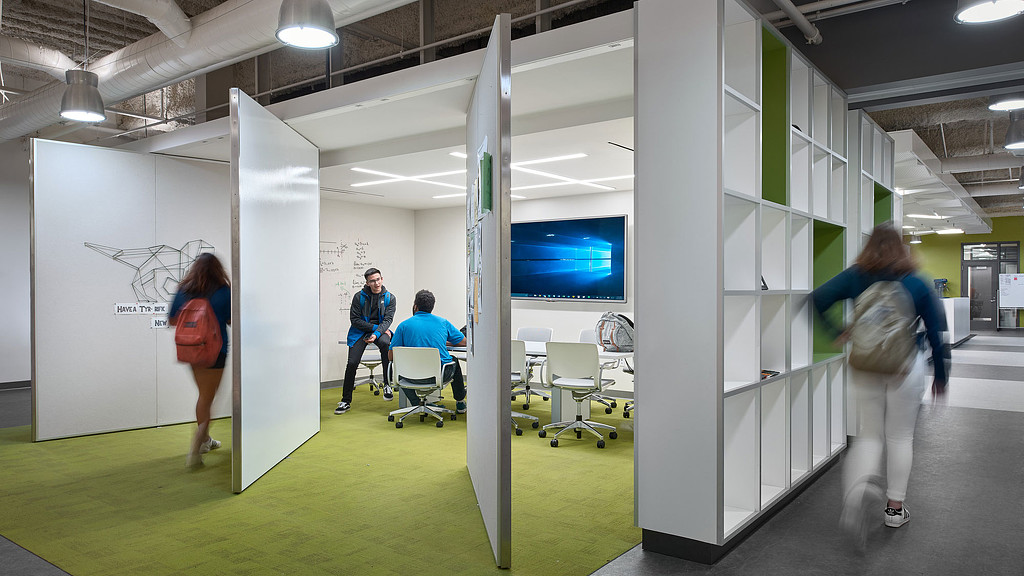What Going Back to School Might Look Like
May 14, 2020 | By Mark Thaler and Patricia Nobre
Editor’s Note: This post is part of our ongoing exploration of how design is responding to the COVID-19 pandemic.
It has been almost two months since U.S. schools closed their doors to stem the spread of the coronavirus, and doors to classrooms won’t open any time soon. As recently as last week, several state governments have mandated that schools shall remain closed for the rest of the academic year while also directing academic institutions to submit re-entry plans for approval before being allowed to open in the fall.
What does the future of education look like, and what should schools be doing now to prepare?
Over the past several weeks, we’ve been presenting this question to school leaders and educators from across the primary school spectrum, including public, charter, and independent schools. We’ve also been talking to thought leaders in education programming and teacher training.
While all agree that this has been an extremely difficult time, they have also learned a great deal about how schools might navigate this time of unprecedented change.
Here’s what we’ve learned:
Online learning: challenges, best practices, and silver liningsMany schools reported challenges associated with the shift to online learning, including lack of student connection and engagement, attendance, self-motivation, lack of privacy practices, and lower quality work produced by the students.
There is great concern that the “summer slide” — the tendency for students to lose some of the achievement gains they made during the previous school year — will have actually started in March instead of June and that the ramifications will be felt well into next year.
But other schools reported that their virtual shift has been much more successful. These schools took a proactive approach to remote teaching, such as establishing new routines and rituals early in the process; scheduling time for small-group discussions; designating longer chunks of time for deeper work; helping students form study groups; and prioritizing time for individual connections.
Short-term strategies for re-occupancyThe foremost concern for school leaders is getting back into their schools and figuring out how to operate in this new environment, while at the same time delivering a feeling of safety and instilling a sense of confidence in their communities.
While schools will operate differently, many are considering strategies that are being implemented in China, Germany, and elsewhere. These include things such as creating smaller class sizes and/or alternating schedules; creating up/down staircases; arranging desks to meet physical distancing guidelines; using signage and wayfinding to indicate distancing protocols; and using lobby space for monitoring and testing of all those who enter the school.
Life after COVID-19: Resilience and flexibilityIn 2018, Gensler published our Design Trends for Education. This study concluded that the future of learning is learner-centered, which implied a major repositioning of the learner, the role of the educator, and the environments we design.
We found that learning outcomes are no longer so prescriptive, and the path of the learner may take on a number of routes towards success. These findings are even more applicable in a post-COVID world.
Schools will need to be designed to engage students and teachers in a setting that supports a dynamic, collaborative, and learner-centered process. They should provide settings that enhance and reinforce culture and anticipate future disruptions in the school year by providing spaces that can flex at a moment’s notice.
For most schools, financial resources will be profoundly impacted in the new COVID-19 economy, and many were struggling prior to this pandemic. Economical and scalable strategies for resilience and flexibility will be critical for these economically challenged schools.
Here are four practical considerations for any school to prepare for a resilient and optimistic future:
1. Agile classrooms should flex and adapt to meet changing needs.The workhorse space in any school is the standard classroom. To the maximum extent possible, these spaces should be sized to enable multiple configurations, allowing students to curate the space based on the needs of the group and the activities happening. There are many offerings for classroom furniture, but desks that can be individual or clustered into groups offer the most flexibility. The teacher station should also be mobile, allowing them to “get out of the way” when the activity dictates it.
2. Flexible spaces for creating can enhance learning and spur motivation.It’s important that schools offer spaces that can support problem-based learning activities, which can spur intrinsic motivation in students. Flexible, multi-purpose workshop spaces that enable hands-on, project based activities allow schools to maximize use of these valuable resources. Furniture solutions such as rolling storage and movable worktables that can be ganged together allow these spaces to be dynamically curated. These spaces promote skills that previously may have been categorized as “soft-skills” but are now crucial educational proficiencies, as companies are increasingly looking for people who can do things like communicate clearly and solve complex challenges.
3. Ubiquitous technology gives students the tools they need to chart their future.Prior to COVID-19, classroom technology was already playing an increasingly important role in curriculum and pedagogy, and moving forward, the need for integration will only be amplified. Distance technology such as cameras, microphones, and displays will need to be ubiquitous, and any space, be it a classroom, office, or home, will need to become a production studio and teaching space. With these integrated platforms, digital learning environments, and personalized pathways, students will have the tools they need to craft their own learning map and future, and they will have the added benefit of allowing schools to move to remote learning at a moment’s notice. It will take a culture of innovation, not to mention adequate resources and funding, among the entire school for this to be successful.
4. Space for culture and community is essential, whether physical or virtual.All of the schools we spoke with were passionate about the importance of culture and community, whether it be in a physical or virtual space. In many schools prior to COVID-19, community connection took place in spaces such as the cafeteria, club rooms, the library, gymnasium, auditorium, hallways, outdoor fields, and even the classroom. These spaces will continue to be critical, but may need to be re-thought in terms of future flexibility. For example, rather than having only large tables and chairs in the cafeteria, schools might populate the space with a variety of furniture such as soft seating, high-top tables, and booths to accommodate smaller social gatherings in off-lunch hours.
Schools are not just a collection of spaces. They are complex ecosystems through which students move each day on their learning journey. To meet students’ needs, schools must provide a level of choice, diversity, multimodality, and flexibility. While virtual learning will likely continue, the visceral experience of place remains relevant.
By thinking about schools as ecosystems, school leaders will have the ability to not only use a variety of spaces to their best advantage, they can also be better prepared to meet an uncertain future.
For any media inquiries, please email .


